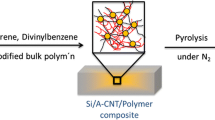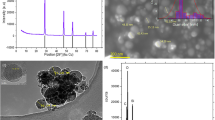Abstract
Silicon has received high interest as an anode material for lithium ion batteries due to its large theoretical Li storage capacity. However, poor cyclability and low coulombic efficiency of the Si based electrode, caused by the pulverization of the active material and the continuous formation of unstable solid electrolyte interphase (SEI) due to large volume change associated with Li, limits its practical use as an anode material. We have developed a Si nanotube array sheathed with silicon nitride compound to improve the mechanical integrity, resulting in improved electrochemical performance. The SiN/SiOxNy outer shell has excellent mechanical properties, such as a high elastic modulus and hardness. This guides the volume expansion of the Si into the hollow inner space of the tubular structure during charge, which prevents both the pulverization of the Si active material, as well as continuous SEI layer formation by protecting the exposure of fresh Si surface to the electrolyte. Si nanotube array sheathed with silicon nitride electrode compound exhibits improved electrochemical performance, including stable capacity retention and high coulombic efficiencies, over the analogous homogeneous Si nanotube system.





Similar content being viewed by others
References
L.Y. Beaulieu, K.W. Eberman, R.L. Turner, L.J. Krause, J.R. Dahn, Colossal reversible volume changes in lithium alloys. Electrochem. Solid State Lett. 4, A137–A140 (2001)
B.A. Boukamp, G.C. Lesh, R.A. Huggins, All-solid lithium electrodes with mixed-conductor matrix. J. Electrochem. Soc. 128, 725–729 (1981)
G. Carlotti, L. Doucet, M. Dupeux, Elastic properties of silicon dioxide films deposited by chemical vapour deposition from tetraethylorthosilicate. Thin Solid Films 296, 102–105 (1997)
C.K. Chan, H.L. Peng, G. Liu, K. McIlwrath, X.F. Zhang, R.A. Huggins et al., High-performance lithium battery anodes using silicon nanowires. Nat. Nanotechnol. 3, 31–35 (2008)
Z.X. Chen, M. Zhou, Y.L. Cao, X.P. Ai, H.X. Yang, J. Liu, In situ generation of few-layer graphene coatings on SnO2-SiC core-shell nanoparticles for high-performance lithium-ion storage. Adv. Energy Mater. 2, 95–102 (2012)
Z.W. Deng, R. Souda, XPS studies on silicon carbonitride films prepared by sequential implantation of nitrogen and carbon into silicon. Diam. Relat. Mater. 11, 1676–1682 (2002)
V. Etacheri, R. Marom, R. Elazari, G. Salitra, D. Aurbach, Challenges in the development of advanced Li-ion batteries: a review. Energy Environ. Sci. 4, 3243–3262 (2011)
K. Evanoff, J. Benson, M. Schauer, I. Kovalenko, D. Lashmore, W.J. Ready et al., Ultra strong silicon-coated carbon nanotube nonwoven fabric as a multifunctional lithium-ion battery anode. ACS Nano. 6, 9837–9845 (2012)
T.D. Hatchard, J.R. Dahn, In situ XRD and electrochemical study of the reaction of lithium with amorphous silicon. J. Electrochem. Soc. 151, A838–A842 (2004)
H.G. Hu, A.H. Carim, Determination of attenuation lengths and electron-escape depths in silicon-nitride thin-films. J. Electrochem. Soc. 140, 3203–3209 (1993)
Y.S. Hu, R. Demir-Cakan, M.M. Titirici, J.O. Muller, R. Schlogl, M. Antonietti et al., Superior storage performance of a Si@SiOx/C nanocomposite as anode material for lithium-ion batteries. Angew. Chem. Int. Ed. 47, 1645–1649 (2008)
I. Kim, P.N. Kumta, G.E. Blomgren, Si/TiN nanocomposites—novel anode materials for Li-ion batteries. Electrochem. Solid State Lett. 3, 493–496 (2000)
J. Kong, W.A. Yee, Y. Wei, L. Yang, J.M. Ang, S. Phua et al., Silicon nanoparticles encapsulated in hollow graphitized carbon nanofibers for lithium ion battery anode. Nanoscale (2013)
X.H. Liu, H. Zheng, L. Zhong, S. Huang, K. Karki, L.Q. Zhang et al., Anisotropic swelling and fracture of silicon nanowires during lithiation. Nano. Lett. 11, 3312–3318 (2011)
P. Patel, I.S. Kim, P.N. Kumta, Nanocomposites of silicon/titanium carbide synthesized using high-energy mechanical milling for use as anodes in lithium-ion batteries. Mater. Sci. Eng. B-Solid State Mater. Adv. Technol. 116, 347–352 (2005)
Q. Si, K. Hanai, T. Ichikawa, A. Hirano, N. Imanishi, Y. Takeda et al., A high performance silicon/carbon composite anode with carbon nanofiber for lithium-ion batteries. J. Power Sources 195, 1720–1725 (2010)
T. Song, H.Y. Cheng, H. Choi, J.H. Lee, H. Han, D.H. Lee et al., Si/Ge double-layered nanotube array as a lithium ion battery anode. ACS Nano. 6, 303–309 (2012)
T. Song, Y. Jeon, M. Samal, H. Han, H. Park, J. Ha et al., A Ge inverse opal with porous walls as an anode for lithium ion batteries. Energy. Environ. Sci. 5, 9028–9033 (2012)
T. Song, D.H. Lee, M.S. Kwon, J.M. Choi, H. Han, S.G. Doo et al., Silicon nanowires with a carbon nanofiber branch as lithium-ion anode material. J. Mater. Chem. 21, 12619–12621 (2011)
T. Song, J.L. Xia, J.H. Lee, D.H. Lee, M.S. Kwon, J.M. Choi et al., Arrays of sealed silicon nanotubes as anodes for lithium ion batteries. Nano Lett. 10, 1710–1716 (2010)
J.J. Vlassak, W.D. Nix, A new bulge test technique for the determination of Young’s modulus and Poisson’s ratio of thin films. J. Mater. Res. 7, 3242–3249 (1992)
W. Wang, P.N. Kumta, Nanostructured Hybrid Silicon/Carbon Nanotube Heterostructures: Reversible High-Capacity Lithium-Ion Anodes. ACS Nano 4, 2233–2241 (2010)
H. Wu, Y. Cui, Designing nanostructured Si anodes for high energy lithium ion batteries. Nano Today 7, 414–429 (2012)
W.J. Zhang, A review of the electrochemical performance of alloy anodes for lithium-ion batteries. J. Power Sources 196, 13–24 (2011)
X.N. Zhang, G.L. Pan, G.R. Li, J.Q. Qu, X.P. Gao, Si-Si(3)N(4) composites as anode materials for lithium ion batteries. Solid State Ionics 178, 1107–1112 (2007)
Acknowledgments
This work was supported by the Global Research Laboratory (GRL) Program (K20704000003TA050000310) through the National Research Foundation of Korea (NRF) funded by the Ministry of Science, ICT (Information and Communication Technologies) and Future Planning, the International Cooperation program of the Korea Institute of Energy Technology Evaluation and Planning (KETEP) grant funded by the Korea government of Ministry of Trade, Industry & Energy (2011 T100100369), and the World Class University (WCU) Program (R31-10092) through the National Research Foundation of Korea (NRF) funded by the Ministry of Science, ICT (Information and Communication Technologies) and Future Planning.
Author information
Authors and Affiliations
Corresponding author
Additional information
Taeseup Song and Yeryung Jeon authors contributed equally to this work.
Rights and permissions
About this article
Cite this article
Song, T., Jeon, Y. & Paik, U. Si nanotubes array sheathed with SiN/SiOxNy layer as an anode material for lithium ion batteries. J Electroceram 32, 66–71 (2014). https://doi.org/10.1007/s10832-013-9871-3
Received:
Accepted:
Published:
Issue Date:
DOI: https://doi.org/10.1007/s10832-013-9871-3




